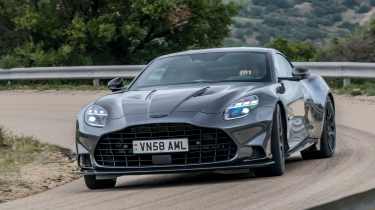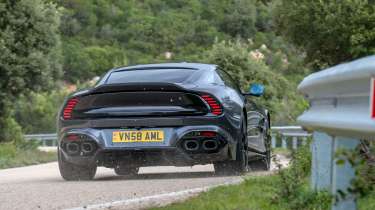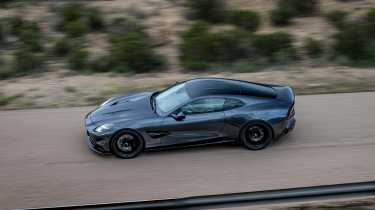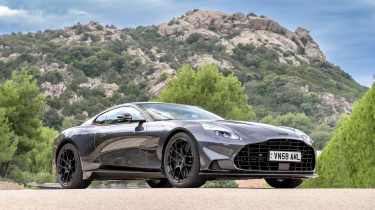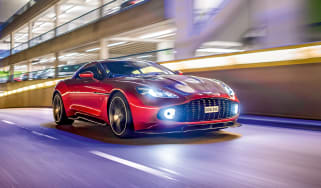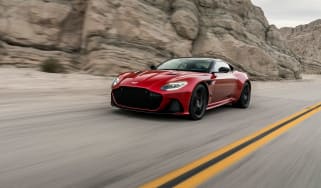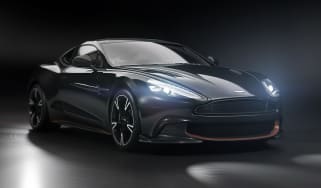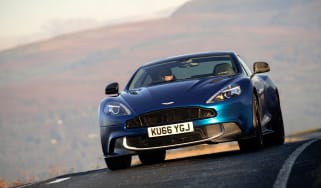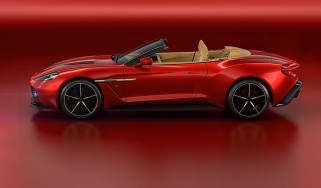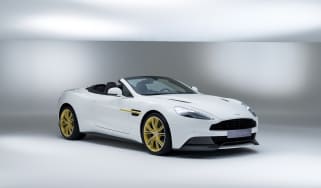Aston Martin Vanquish 2024 review - Britain’s Ferrari 12 Cilindri rival
The third-generation Aston Martin Vanquish is not only the best yet, it’s the best Aston Martin full stop
After all of the chat – the technical insights, the design philosophy, the shaping of the dynamic character, et cetera – after all of that, there’s unvarnished reality and your unfiltered response to it. The first Vanquish I laid eyes on was outside the entrance of the launch hotel and it wowed me. In metallic red with gold wheels, it looked sensational: low, long, beautifully sculpted. For me, without hesitation, it’s the best looking Aston Martin in 25 years. A great start.
The shape looks fabulous, quietly aggressive. Dropping into the driver’s seat, the cabin exudes simple class, the V12 just loud enough. Then, before we’d left the hotel grounds there was a strong hint that it was going to deliver dynamically, because it tackled the speed humps with the suppleness of a proper GT.
The new Vanquish needs to hit the ground running because Ferrari’s 12 Cilindri targets the same buyers and has uncannily similar headline stats. The Aston makes 824bhp, has a top speed of 214mph and gets from 0 to 62mph in 3.3sec, while the Ferrari has 819bhp, a top speed of 211mph and hits 62mph in 2.9sec. And they both cost one third of a million pounds, give or take.
More reviews
In-depth reviews
Reviews
Despite all the similarities, including their front-mid-engined layouts, there is one fundamental difference and it’s all about those V12s, which promise quite different experiences. The Ferrari’s is big capacity, naturally aspirated and revs to 9500rpm; the Aston’s is smaller in capacity but has two turbochargers, which means their deliveries are utterly different. Compare torque figures: at 2500rpm the Ferrari delivers 400lb ft, the Aston a massive 737lb ft, over 80 per cent more. We’ll come back to that later.
This is the third Vanquish that started with Ian Callum’s original in 2001 followed in 2011 with the second-generation car, which was arguably a Vanquish in name only and much closer to the noughties DBS (specifically underneath), which it replaced. Taking on the mantle of Aston Martin’s flagship from last year’s mighty DBS 770 Ultimate, the new Vanquish shares hardly anything with that car; not the chassis, not even the engine, despite it having the same capacity and the same bore and stroke dimensions.
It’s an all-new 5.2-litre V12 that has been five years in the making that was delayed a little by Covid. Literally everything is new and optimised for efficiency and power – the cylinder block, the heads, the reprofiled camshafts, the combustion chamber design, the intake and exhaust, the higher pressure injection system, even the turbos, which are the same size but have less inertia and are faster responding and higher revving. homologating an all-new V12 to global emissions standards with the ban on pure ICE cars looming is not the work of a moment.
Meanwhile, the bonded aluminium chassis has been extended by 80mm between the A-pillar and front axle line, which, along with an increase in overall length of 135mm, helps give the new car its long, lithe profile. The front and rear tracks have been widened, by 15mm and 25mm respectively, and there’s a new front crossmember and strut-brace to help increase lateral stiffness by 75 per cent. Suspension attachment points have been beefed up and there’s a solidly mounted steering column for better steering fidelity, particularly on-centre but in transient manoeuvres and at high speed too.
Unstressed body panels are fabricated from carbonfibre rather than the pressed aluminium saving 40 per cent in material weight and on tooling, too, with Aston committed to building no more than 1000 per year. A closer look reveals that there are quite a few naked carbon bits, notably the roof with its neat swage-lines and the panel between the tiered rear light units that Aston calls the ‘shield’, plus the mirrors and various addenda such as the front splitter, the rear diffuser and the bonnet vents, which help relieve high pressure in the engine bay. Increasing in size and packed with more technology, including ADAS devices, the claimed kerb weight has increased by 65kg to 1835kg. There are no rear seats this time but the rear buckets of the DBS were more ornamental than practical.
The dashboard design is familiar from DB12 and Vantage, which is great from a style perspective, not so great from an HMI angle because the typefaces used in the TFT screens are still way too small. Satin-finish carbon trim spans the facia, contrasting with the smooth leather, and further contrast is provided by the ‘parmesan grater’ grills for the multiple Bowers & Wilkins speakers. There are some lovely touchpoints, including the stubby gear selector and the knurled rotary switches that sit either side. It’s a shame there are a few hangover bits from the DBS, such as the switches for the electric seats and door mirrors, as they do jar slightly.
Aston chose to launch the Vanquish on the Italian island of Sardinia, which is neat because the hotel we’re staying in is the Cala di Volpe, the one featured in the Bond movie The Spy Who Loved Me (yes, he drove a Lotus Esprit in that film…). The location shows confidence because the roads are quite a mixed bag, some smooth and flowing, many choppy and broken, so there’s quite a bit for a car to deal with. That early sign that Vanquish’s ride was going to match its GT ambitions is quickly and repeatedly confirmed; it’s a compliment that you don’t find yourself steering around surface imperfections because you know the ride will take the edge off all sorts of rough stuff. In fact, there’s probably more road noise than there is ride disturbance.
The tyres are enormous: 275/35 ZR21 front and 325/30 ZR21 rear, Pirelli P Zeros, AML spec, of course, and preferred over a Michelin for its naturally more absorbent sidewall and Pirelli’s Noise Cancelling System (PNCS) – a series of foam pads bonded to the tyre inner. The tyres are mounted on lovely, thin-sparred wheels, the structure of which has been optimised using computer simulation to remove excess weight (they’re lighter than any previous 21-inch Aston wheel). Standard-fit carbon-ceramic brakes, massive 410mm discs on the front, 360mm on the rear, save a 27kg versus an iron/steel set-up.
Suspension is by double wishbones at the front and multi-link at the rear, with Bilstein DTX damper technology to deliver a supple secondary ride and strong primary control. Larger diameter anti-roll bars increase roll stiffness, and the final piece of the dynamic control hardware is the first deployment of an e‑diff on a V12 Aston. Unlike a conventional mechanical locking diff, an e‑diff can be open, locked or anything in between in a few milliseconds, offering more opportunity to influence agility and traction.
All of which sounds impressive, so what does the Vanquish actually feel like? The steering efforts are a fraction high, but once you’re into the swing of a few corners, it feels spot on. In fact, GT mode is really well judged and you could leave it there forever and the Vanquish would do everything you wanted it to with aplomb. There’s a really natural, linear feel to the steering, you get a good sense of what’s going on at the front and the car feels well balanced and agile. It’s keen to turn, and you can be really accurate with it. For me, Aston’s other recent offerings, the DB12 and Vantage, steer too brightly with a ride that’s overly firm, which makes them amazingly direct but lacking in warmth. The Vanquish is different. Its response to inputs is more measured and natural, so on a winding road you know where you are with it. Consequently, you quickly get into a flow and find a satisfying rhythm. Of course, it’s absolutely ballistic if you want it to be, but it does the comfortable lope too.
In auto the eight-speed ZF auto (the same as fitted to the new M5) finds the optimum gear smoothly and quickly and manages the 737lb ft of torque; which be the limit for the ’box because in both cars the shift speed is no faster in the sportier settings (in the Vanquish that’s Sport and Sport+). Not that this is much of an inconvenience. In fact, it’s such a great sounding engine that you want to hear it working through the revs, so select manual, use the paddles and enjoy the feeling and sound of the V12 getting its shoulder behind the mass of the Vanquish. At 1835kg it’s about 100kg more than the 12 Cilindri, but peak torque is available from 2500 to 5000rpm – the torque curve looks like Ayers Rock – so it’s not long before the V12 is reeling in the horizon, its note guttural at first then a glorious howl.
To lend some differentiation to the various modes, the torque is managed in the first six gears in GT mode, each getting its own torque curve. It’s not managed in any gear in Sport and Sport+, but in wet mode it’s limited to 442lb ft.
A walk-round reveals that the Vanquish looks great from every angle; the more I look, the more it appears like an evolution of the One‑77, in features as well as proportions: the wide-mouthed grille, the ‘bow-and-arrow’ flank detail, the shape of the panel between the rear lights, the kick up of the side window line… The Vanquish is also one of those cars that looks even more dramatic amongst other traffic – and when you’re able to walk around it and see how the light moves over certain surfaces, particularly the sculpting of the door.
On the move it’s plenty fast enough in GT, but ramp things up to Sport or Sport+ and the throttle response is stronger, the performance harder-edged and more insistent. The whole car tenses up slightly and there’s always a slug of instant urge when you crack open the throttle. The credit isn’t all down to the lighter, faster-accelerating turbos; the Vanquish has ‘boost reserve’, a system that anticipates throttle demand and on part-throttle builds boost in readiness for the next request, thereby giving crisper response. And while boost reserve may win back fractions of a second in response that would otherwise be lost, in the grand scheme I think it matters not. The scale of performance in the Vanquish is so epic, so monumental, it’s almost irrelevant. Find a decent straight, nail it and hear the V12 roar as it accelerates with such solid determination that it feels like it’s going to keep piling on the speed at an unabated rate until you run out of nerve, or road, or hit 214mph.
Dynamically, the Vanquish is pretty well balanced, its static distribution split 51:49 front-to-rear. Attack a corner and you get the sense of how hard each axle is working through the steering wheel and the seat of your pants, so you can predict what will happen if you inject a chunk more power into the mix. You can also get a feel for how the car will behave unrestrained by disabling stability but using scalable traction control to creep up on the limit of rear grip. The Vanquish loads up evenly, more throttle will jink the tail out – what else? – but grip is exceeded and returns relatively easily for such a big, potent car. It all feels a bit academic, though, because there’s such a breadth of entertainment and satisfaction to be had without smoking the rear tyres.
The Vanquish ticks an awful lot of boxes: It looks wonderful, sounds amazing and offers spectacular performance. It’s sharp, tactile and engaging when you want it to be, satisfying the super-GT part of the brief, and nails the pure GT part too, with a continent-crossing combination of supple low-speed ride, firm but comfortable seats, superb wind noise refinement and an outstanding sound system. The brakes are outstanding too, with a great sense of power and great feel. Downsides? High road noise, relative lack of space for such a big car, the odd bit of old switchgear and the tiny typeface in the HMI.
Vanquish versus 12 Cilindri, which will prevail? If push comes to shove, my money’s on the Vanquish. Yes, it’s that good. The best Aston of the last 25 years, no less.
Price and rivals
Aston Martin’s new flagship costs from £350,000, a figure that cannot be taken lightly. It’s a significant sticker price for the British brand considering its financial performance post IPO, and some of the struggles dealers have with stock and how long it sticks around. It’s a challenge new CEO Adrian Hallmark is already addressing.
You might point out that Ferrari charges a similar amount for its new 12 Cilindri at £336,50 before you go anywhere near the options list, but Ferrari is Ferrari…

